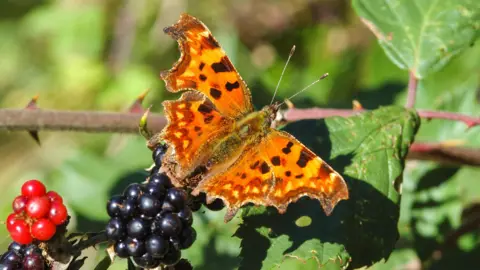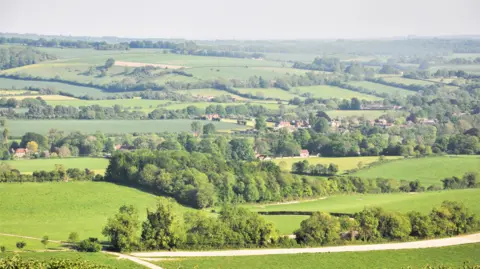Butterfly numbers 'boosted by trees and hedgerows'
 Jim Asher
Jim AsherTrees, hedgerows and small copses can significantly increase the number of butterflies in farmed landscapes, a study has found.
Oxford University carried out research with the Butterfly Conservation charity which found ancient trees were associated with higher butterfly species richness.
The study, funded by The Woodland Trust, found that despite butterflies being in "desperate trouble", farmland can play a "vital role" in helping species recover.
Other work by Dorset-based Butterfly Conservation found earlier this year that half of the UK's butterfly species' populations were in long-term decline.
"We know that butterflies are in desperate trouble, including our common countryside species," Dr Ruth Feber, from Oxford University, said.
"Butterflies are important indicators of wider biodiversity, so actions that help butterflies will also help other declining wildlife.
"With 70% of the UK's land area being farmland, our farmers and landowners play a vital role in helping these species recover, through protecting and restoring hedgerows and trees."
Researchers found, while many farmers were aware of the benefits brought by trees and hedgerows, they were concerned about the costs and commitment of maintaining them.
 Ruth Feber
Ruth FeberDr Feber added: "It's clear that farmers recognise the importance of these crucial habitats, but they need to be supported: we need to recognise that these trees and hedgerows provide public goods which benefit wildlife and people."
Earlier this year the UK Butterfly Monitoring Scheme found 31 of 59 species have had their numbers fall since 1976, when monitoring began.
It also found that 2024 was the fifth-worst year for butterfly numbers across the country, with all but eight species suffering declines on the previous year - though populations can fluctuate year-on-year in response to the weather.
Helen Chesshire, the lead advocate for farming and agroforestry at the Woodland Trust, said: "We know that trees outside woodlands have a range of benefits, from providing habitats and microhabitats, to mitigating the effects of climate change, and it's encouraging to see from this study how beneficial they are to butterflies in particular.
"Trees and hedgerows provide habitat connectivity across what can be a hostile environment for wildlife, so we welcome the positive response from farmers, and their interest in receiving advice on managing these valuable trees. It is vital that farmers are given the support they need to do this."
You can follow BBC Oxfordshire on Facebook, X (Twitter), or Instagram.
